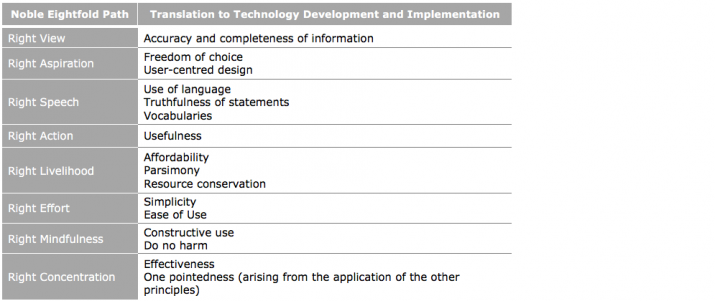FEATURES|COLUMNS|Mindful Technology
Towards Dharma-driven Systems Awareness
 From pixabay.com
From pixabay.comTechnology permeates every aspect of modern life and inevitably influences even the purest Dharma practice. It is not uncommon to find monks and other dedicated practitioners being dependent on their smart phones, which is sometimes viewed as a lack of devotion. “Look at all the monks using their mobile phones all the time,” I often hear critics say when they visit monastic institutions and see monastics engaged with their gadgets. Many monks, of course, use mobile phones to listen to or give teachings, to communicate with lamas, and to listen to prayers and chant along.
This column, Mindful Technology, discusses how technology can enhance and promote enlightened human experience, and this article is aimed at providing an introduction to “awareness-driven design.” It presents an overview of the path leading from technical to sociotechnical systems, and discusses how system developments can emerge in alignment with mind science and the understanding of human consciousness. It also proposes that the core values of the Dharma can be leveraged to support and enhance the engineering of systems awareness.
From technical to sociotechnical
The engineering of information and communication technologies, such as computers, mobile devices, software applications, was traditionally approached from a strictly technical perspective. Design was determined by technical functions and quantifiable input and output. In recent decades, however, technologies are increasingly considered in a sociotechnical context, where the boundaries of technical systems are designed to include people and their environment.
Sociotechnical systems (STS) are dynamic, adaptive systems resulting from the interaction between people, tools, techniques, and knowledge, designed to deliver a desired functionality. This definition considers systems as consisting of three interdependent aspects—social, technical, and environmental—which must be aligned and work together for the functionality of the system to be optimized. Sociotechnical system approach to systems design and engineering is very important: as research shows, critical system failures often occur due to “non technical” reasons. Despite flawless technical implementations, failures occur due to human (cognitive and behavioral) aspects and sociotechnical factors. In most systems, functional performance depends on the interaction between people and technologies, and the correct functioning of systems depends largely on interactions with different kinds of users, in different situations.
Nowadays, user-centered design approaches radically influence the design of information technology. These approaches developed as a reaction to the first generation of computers and machines that were designed by engineers for engineers, and required significant training before they could be used. It was only in the late 1980s and early 1990s that people began applying formative evaluation techniques to the design process. As a result of this cultural evolution, users today are no longer passive recipients of the final product, the design process being external and unrelated to them, but become involved at an early stage and contribute to the production cycle. It is not just the user who contributes, it is also the supplier, the business partner, and the employee. This is also referred to as “collaborative design” or “co-design,” and is one of the most exciting frontiers in research and innovation today. This shift toward people-centric approaches, collaborative and participatory design, and open and community-driven innovation is symptomatic of broader changes in society (due to the availability of network information technologies that are changing not just the way people communicate, but also the way they work), as well as the result of a shift in consciousness that drives human evolution. There are various reasons why we should adopt people-centric approaches, one is the reduction of risks associated with new technology.
Systems and awareness-driven design
When it comes to modeling the social aspects of technology (i.e. people, as individuals and as a collective), engineers consider human behavior as the main variable. Behavior is defined as being determined by knowledge and awareness. Scientific disciplines devoted to understanding knowledge and behaviors—e.g. ontology, epistemology, philosophical enquiry, knowledge engineering, and knowledge management—can help to understand and model the knowledge layer in technical systems. Sciences studying knowledge in human (social) systems have been around for a long time, but the study of knowledge and intellectual applications in technology is merely half a century old. The notion of the “knowledge layer” in the computing domain came about in the 1970s, when the first intelligent systems were being developed. “Awareness” design in technology systems is a much more recent development. Systems awareness is determined by the capability of systems to “sense” states. In simple terms, light sensors that automatically switch off when its dark, or heating systems that are triggered by temperature changes, translate physical cues into action, making the systems physically “aware.”
Systems awareness and awareness-driven systems design
Research on human factors (HF) suggests that situation awareness (SA)* is a crucial design paradigm for the development of new systems, one that allows human beings to understand and anticipate available information effectively. Modern systems are becoming increasingly sophisticated, and can surprise users with their unprecedented ability to detect situations, self adjust, and make intelligent decisions autonomously. The simplest form of awareness is enabled by physical sensors, but sociotechnical complexity is already underway. More subtle emotion-detection capabilities are possible via “sentiment analysis” and “emotion analysis.”** The next challenge consists of developing systems capable of helping humans expand their consciousness and achieve an optimal state, where all the latent faculties can emerge. What does that mean, how will that be achieved?
Dharma values applied to the principle of awareness-driven design
In these troubled times, awareness-driven design can help to support enlightenment by designing systems that help humans make constructive and optimal decisions. Similarly, enlightened values can help to devise enlightened systems. In the table below, I map the principles of the Noble Eightfold Path and match them with the corresponding principles and good practices of enlightened systems design. In future articles, I will provide examples and a discussion of each of these principles and practices.
 Dharma values mapped to principles of good systems design. Image courtesy of author
Dharma values mapped to principles of good systems design. Image courtesy of author













